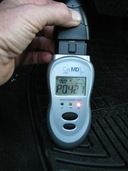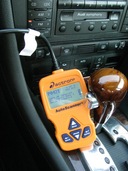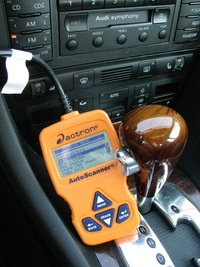Buying A Used Car? A Review Of Scan Tools That Can Help You Get Smart Not Screwed
By Thom Cannell
Senior Editor
Michigan Bureau
The Auto Channel
Buying a used car is daunting and frightening, even for veteran automotive reporters. Though I have changed oil and windshield wipers, replaced shock absorbers, even rebuilt engines and gearboxes, sorting through classified ads in the newspaper and on even Internet car sale sites like The Auto Channel’s USED CAR SUPER SEARCH) still makes me feel queasy like a novice.
Once upon a time it was easy to identify a good car from one you’d never want. Rust, smoke from the exhaust, or a clunking transmission were strong signals to run away. Now that ten year old cars look shiny and new, rusty fenders are a bad memory, and working on cars requires a PhD in computer science, how do you tell a lemon from a peach? The answer is “diagnostics”.
Dealers have diagnostic tools that cost thousands of dollars and can assist a skilled mechanic in figuring out what is causing your loss of fuel economy, an illuminated “Check Engine” light, or many other service-related problems. Dealers also charge $50-$100 for the service as the mechanic’s time retails for $85 per hour and the big shiny computer cost them as much as $15,000.
For those of us searching for a second car, a vehicle for college-bound kids, or even our first vehicle, there are devices that can help assess the complex systems in our post-1996 vehicles. Why 1996? That was the year that On Board Diagnostic standards became mandatory.
The result of OBD was to provide a connector that any mechanic equipped with the proper “scan tool” could use to receive information from all the various microprocessors controlling the vehicle. Those included transmission controllers, engine controllers, fuel injection controllers and others. Today you can purchase an inexpensive code reader or scan tool that costs $50-$300 and will offer you some of the vital information the $6000-$10,000 scan tools that dealerships and independent garages use. Note that I said some, not all. This is a critical distinction that could cost, or save you thousands of dollars.
I chose two very different kinds of scan tools for our testing and comparison to see which type of tool is best either average customers or experienced mechanics. They are the $120 CarMD, introduced in 2010 with software recently updated, and similarly priced Actron 9575 Trilingual ODB II and CAN Scan Tool, one of Acrton's variety of scan tools. What attracted me to these tools was their claim of ease-of-use and an ability to translate technical jargon into understandable language.
Impressions out of the box
From the beginning, even the packaging reflected who each company sees as its potential customers. The Actron scan tool arrived in utilitarian packaging with a simple box and multi-language instruction book (it speaks French and Spanish as well). CarMD is far more consumer oriented and the neat zippered carry pouch reflects this. The Acrton tools have long attachment cables; CarMD expects to plug directly into the OBD II port, impossible for many non-domestic vehicles. An extra cost extension cable is available.
Now for some test results; first I inspected a high mileage Chevrolet with no known engine or transmission issues with both devices, each gave the Chevy a no-problem result. It was very cool to be able to drive the car with the Actron attached and monitor various systems, watching temperatures rise and the fuel injection system’s progress.
OK, actually it’s more than cool, it is amazingly useful in diagnosing transient problems that never seem to show up when you take the car to a dealer to fix a problem. Here the Actron scanners shine, albeit kind of mechanic-geeky.
|
|
Regardless, I tried both tools and neither gave us an immediate diagnosis. Actron showed no codes or problems despite the car not starting; CarMD showed a yellow light. Once connected to CarMD’s website we got a generic diagnosis of: “ENGINE: There is either a pending problem or your vehicle’s systems have not run all of their tests”. Hardly better than nothing.
Second car was a used Audi 2001 allroad
CarMD was used with its long extension, and grabbed several codes. At the office I plugged it in, then entered mileage and VIN. According to CarMD the check engine light is on and the emissions system is failing in some critical areas. CarMD says the vehicle would likely fail an emissions test, vital knowledge for a Californian and some other states. Actron simply displayed the codes and a short description
 |
 |
Both Actron and CarMD gave identical definition for the codes they pulled from the onboard diagnostic system. For instance, both say code P0161 is Oxygen Sensor Heater Circuit Bank 2 Sensor 2. I checked code meanings with both services. For CARMD, hooking up the device to a supplied USB cable and launching the supplied software (they recommend an automatic launch, I do not,) it did all of the code searching and popped up a page with all the codes it had gathered.
Similar code data is available on Actron’s website, as well as being directly displayed on the hand-held unit. Diagnostic codes are necessarily brief. You can find expanded meanings on www.actron.com/code_lookup.php regardless of owning a device. It displays generic fault code, like DTC P0056, and the definition of that code (Diagnostic Trouble Code definition: Heated Oxygen Sensor Heater Control Circuit Bank 2 Sensor 2.)
Actron owners can also access an owner’s service at www.repairpath.com. They supply valuable, but not comprehensive, information on labor, maintenance intervals, and removal and installation procedures for a fee. Oh, anyone can look up OBD codes at www.obd-codes.com and the internet provides a host of specific vehicle-centric information.
For those of us who don’t interpret OBD II codes often, searching for the code named by either device (like DTC P0056) should produce an answer. What CarMD does better than Actron is tell you yes (green), maybe (yellow), or no (red). For a non-mechanic, someone who never has and never will work on their own vehicle, CarMD may be the better solution, particularly coupled with their extra cost premium plan.
Others, those who do their own work and are comfortable with “Oh, the old P0056, someday gotta think about replacing the oxygen sensor”. Another benefit is using Actron’s ability to watch for transients—from the passenger seat, please!
So the bottom line, if you’ve read this far, is CarMD, or Actron’s latest better for you? Neither (yet) reads ABS brake information, which is a significant concern. Either will offer codes stored in the onboard computer, however only the Actron will allow you to clear codes for testing. Our advice, if you’re technological, the Actron CP9575 is your better bet. If not, go with CarMD. Either way you’ll be a happily informed buyer…as we say here at The Auto Channel, “Get Smart, Not Screwed!”



